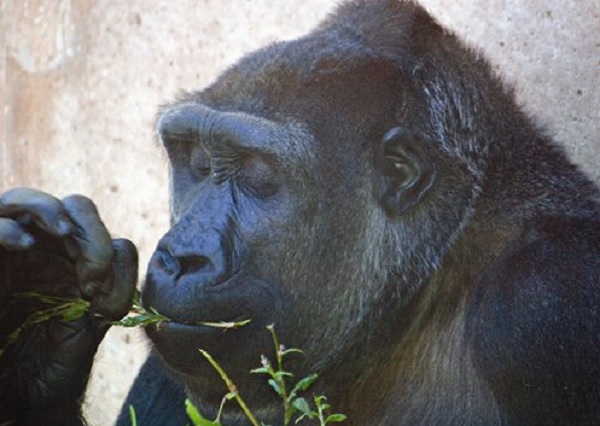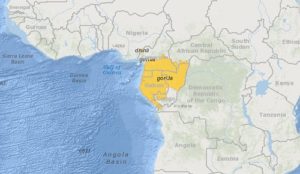
A Western Lowland Gorilla from the Philadelphia Zoo
Interesting Facts about Gorillas
- Gorillas develop twice as fast as humans.
- Gorillas share 95% of our human genome.
- A group of gorillas is called troop.
- The Western Lowland Gorilla is the subspecies that is often found in zoos.
- American zoologist George B. Schaller was the first scientist to study and observe gorillas. He published his findings in his book “The Mountain Gorilla: Ecology and Behavior”

Conservation
- Western Gorillas are listed as Critically Endangered by the IUCN Red List of Threatened Species.
- The species is listed under Appendix I of CITES and Class A of the African Convention.
- National and International law protecting Western Gorillas are in place but lack enforcement.
Taxonomy

Gunther, a young Western Lowland Gorilla from the Atlanta Zoo
- Kingdom: Animalia
- Phylum: Chordata
- Class: Mammalia
- Order: Primates
- Family: Hominidae
- Genus: Gorilla
- Species: Gorilla gorilla
- Subspecies: Gorilla gorilla gorilla – Western Lowland Gorilla
- Subspecies: Gorilla gorilla diehli – Cross River Gorilla
o
o
Name
- Common name: Western Gorilla.
- Scientific name: Gorilla gorilla.
Distribution
- The Western Gorilla has two recognized subspecies: Western Lowland Gorilla (Gorilla gorilla gorilla) and Cross River Gorilla (Gorilla gorilla diehli).
- The Western Lowland Gorilla subspecies is found in the Congo River Basin of Western Africa in the countries of Cameroon, Angola, Central Africa Republic, Democratic Republic of Congo, Equatorial Guinea and Gabon.
- The Cross River Gorilla is found in a small area on the Nigeria Cameroon border, in an area of about 3,088 sq miles (8,000 km2). They are found in the Takamanda Reserve in Cameroon and the Cross River National Park in Nigeria.

Western Gorilla Distribution Map. Adapted from IUCN Red List of Threatened Species.
Population
- Western Lowland Gorilla – Gorilla gorilla gorilla
- A study done in the 1990s estimates the Western Lowland Gorilla population at 95,000 individuals.
- The first major cause of population decline in the Western Lowland Gorilla subspecies is commercial hunting. Improvements in transportation have led to increase logging in once inaccessible forest. Bushmeat is widely consumed as it is easily transported to markets.
- The second driver of population decline is disease, specifically the Ebola virus.
- The third one is low birth rate.
- Cross River Gorillas – Gorilla gorilla diehli
- According to the IUCN there are approximately 250 to 300 Cross River Gorillas. Its population is small and fragmented concentrated in up to 11 locations.
- Its small population is surrounded by some of the most densely populated areas in Africa which is degrading its habitat even further. Its habitat is being converted into agricultural and grazing land.
- The size of its population puts the species at risk of inbreeding and loss of genetic diversity.
- Both subpopulations combined have experienced a decline of more than 80% over the past 60 years.
Habitat
- Western Gorillas are found primarily in lowland tropical forest and in swamp forests where there is plenty of food such as leaves, pith, shoots and fruits.
- They establish a homerange of about 7.7 sq mile (20 km2) which usually overlap.
Physical Features
- Gorillas are the largest primates.
- Their skin is jet black and pelage gray brown or gray black. Mature males have silver hair in their shoulders and are known as silverbacks.
- Western Gorillas are smaller than their cousins Mountain Gorillas. They have longer arms and shorter hair.
- The difference between the Western Lowland Gorillas and the Cross River Gorillas is the dimension of their skull and teeth.
- Males average 61 inches (1.55m) while females 53 inches (1.35 m).
- Males weight 350 lb on average (157 kg) and females 180 lb (80 kg).
Behavior
- Gorillas are diurnal. They are active during the day and spend their time foraging on the ground, climbing, feeding, grooming each other or taking naps.
- Every day they build a nest which is used for one night only. They use vegetation to build a nest on the ground or they sleep on trees.
- Gorillas are not territorial but they will protect their group members.
- They are usually peaceful unless threatened.
- Social units are formed by an alpha male, the dominant male gorilla, 3 or 4 females and their young. Groups have up to 20 members. They form smaller groups than Mountain Gorillas.
- Younger males leave the group and stay solitary until they find mates.
- They communicate through vocalization, facial and body expression or by scent marking.
- Gorillas are herbivores. They eat leaves, roots, bark, flowers, stems and fruits. They also eat insects such as ants and termites.
Reproduction
- Western Lowland Gorillas and Cross River Gorillas have a longer birth interval therefore having a slower reproduction. Infant mortality is higher than the Mountain Gorillas.
- Gorillas are polygynous. The male gorilla has more than one female mate.
- Gorillas mate throughout the year, they do not have a mating season.
- Females reach sexual maturity at around 10 years while males at 15 years.
- The average gestation period is 9 months and the female will usually give birth to one offspring, ocassionally twins will be born but it is rare.
- Infants nurse for three to four years.
Life Expectancy
- In the wild Western Gorillas are expected to live from 35 to 40 years.
- In captivity their life expectancy is slightly higher up to 54 years.
References and Further Research
- San Diego Zoo – Western Gorilla
- IUCN Red List of Threatened Species – Gorilla gorilla gorilla
- IUCN Red List of Threatened Species – Gorilla gorilla dielhi
- University of Michigan Museum of Zoology – Gorilla gorilla
- ITIS Report Page – Gorilla gorilla
- National Primate Research Center University of Wisconsin, Madison – Gorilla gorilla
- Ebola Vaccine and Western Gorillas
- Appendix I of CITES
- African Convention on the Conservation of Nature